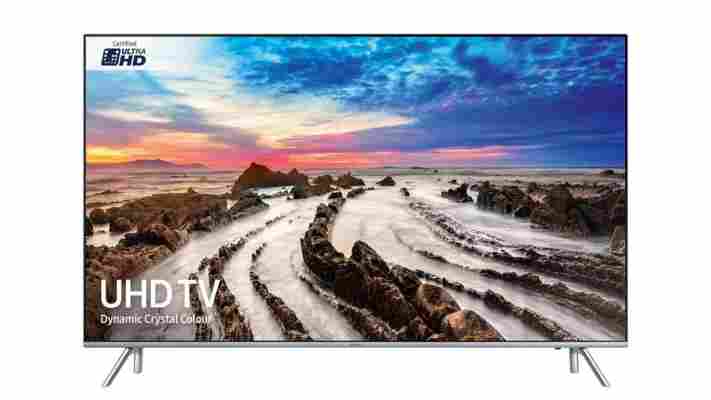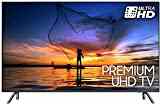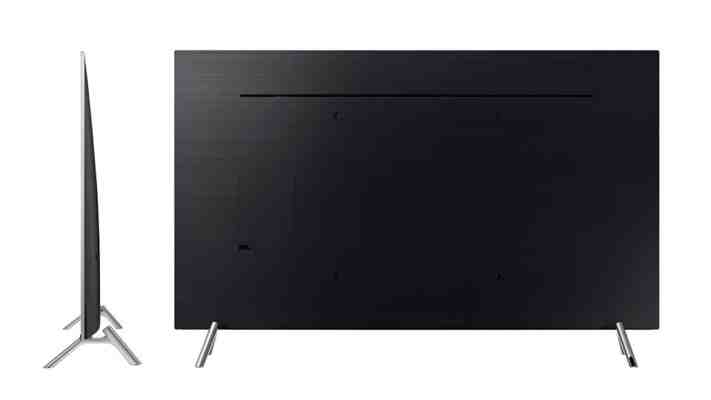Samsung has been heavily promoting its new QLED range of quantum-dot-based TVs this year, but it's the company's more affordable MU series of 4K HDR televisions that will be of interest to most consumers. One such specimen is the Samsung UE55MU7000, a 55in 4K HDR TV that nudges just beneath the £1,000 mark.

Current deals: Samsung UE49MU7070T (was £1,190, now £729)
The 49in version of Samsung's MU7000 has dropped significantly in price. It doesn't have the upgraded 120hz panel of the 55in model, but if you can put up with the 60Hz refresh rate then it still features a smart hub, dynamic colour, a slim bezel and decent HDR performance for the money. It's now available for just £729 – a mighty fine deal indeed.
Buy now from John Lewis


Samsung MU7000 review: Design and connectivity
The Samsung MU7000 sports a premium-looking design that defies its price tag. Its black bezel is rakishly thin, smartly attired with a brushed metallic silver side trim, and widens only slightly at the bottom edge to accommodate the LED backlight module.
The TV stands on a pair of feet that simply slot into place, no screws required. Samsung has also been considerate enough to provide alternative inner slots, which will come in handy for those of you who own narrower AV racks and need the feet closer together.
As is the case on most recent Samsung TVs, the MU7000’s connections are outsourced to an external One Connect box that houses four HDMI 2.0 inputs, each with 4K/60p and HDCP 2.2 support. Two remote controls are supplied: a slick Smart Remote with voice control; and a more conventional button-heavy clicker.
Samsung MU7000 review: Picture quality
Samsung has sensibly opted to use a VA-type panel. As a result, the MU7000 is capable of producing the kind of strong, lustrous blacks that are bettered only by substantially pricier sets, but it also suffers from the usual drawbacks inherent to VA panel technology. For instance, if you’re not sitting directly in front of the Samsung, you’ll notice that the darkest shadows begin to look grey rather than black, and colours begin to lose their lustre. If you can’t position the MU7000 slap bang in front of your sofa, then you’d be wise to look at a TV with a different panel type.
At this price, it’s no surprise to find that the MU7000 is an edge-lit LED LCD television. As there's only one strip of LED modules along the bottom border of the panel to illuminate the entire screen, you can immediately assume one thing: local dimming is going to be limited in its effectiveness. To Samsung's credit, though, it has purposely designed the backlight dimming algorithm not to be overly aggressive, so blooming/haloing artefacts are kept to a minimum (or at least they are while you’re watching standard dynamic range content).
And it’s fair to say that the quality of the panel and backlighting is beyond reproach, even if it isn’t cutting edge. We found the backlight and screen uniformity on our review sample to be excellent, with no significant clouding, corner bleeding, or dirty screen effect (where uneven backlighting causes the screen to look mottled and ‘dirty’ in brighter scenes).
The Samsung UE55MU7000 is also unusually feature-packed for a £1,000 TV. It offers a comprehensive array of calibration controls, and judicious tweaking of these makes it possible to achieve accurate colours for making the most high-definition material.
A couple of motion-enhancing technologies make the feature list, too, as Samsung’s 120Hz panel can deploy frame interpolation or black frame insertion (BFI) to improve motion clarity. The former is effective, but can introduce interpolation artefacts (which manifest as ripples or tears around moving objects) and soap opera effect to 24fps movies (which makes them look overly smooth, like a cheaply filmed soap opera), whereas the latter will appeal more to purists if they can tolerate the ensuing flicker which, in all fairness, is less noticeable than the BFI implementations we’ve seen on other TV brands. There is occasional stuttering during scene cuts – and especially so when you’re watching lower-quality, interlaced broadcasts – but it's not something that everyone will notice.

Samsung MU7000 review: HDR performance and gaming
Fire up a Netflix 4K stream, or pop an Ultra HD Blu-ray in your player, and the UE55MU7000’s HDR performance is surprisingly refined. It supports HDR10 and HLG (Hybrid-Log Gamma) and HDR10+ formats out of the box.
You shouldn’t expect the kind of eye-popping HDR spectacle produced on TVs at twice the price, though. Peak brightness came in at 560cd/m ² after we’d calibrated the TV, and while that’s less than half that of the best sets, it’s the kind of ballpark figure you should expect at this price point.
Samsung's tone-mapping algorithm certainly helps to make the most of the MU7000’s modest capabilities, however. While other manufacturers compensate for weaker backlights by not displaying the brightest HDR highlights, Samsung’s engineers have opted to retain the full dynamic range. That means you won't be missing out on any detail in the brightest highlights, even on HDR content that’s designed with a peak brightness of 4,000nits (which is just over seven times brighter than the MU7000’s peak brightness). As a result, HDR colours always appear natural, even if the most saturated colours lose a little of their intensity due to the VA panel’s limited colour gamut. Dark scenes also tend to look washed out as the backlight has to be cranked right up to handle the demands of HDR.
Another string to the MU7000's bow is its low input lag. We measured 24ms in 1080p, and 19ms in 4K HDR, which makes it an excellent choice for playing reflex-based games. And while some other LCD TVs that employ VA panel technology display smearing and ghostly trails across the screen when a dark object moves against a lighter background, the Samsung 55MU7000’s panel is a cut above – it’s largely free from such issues.
Buy the Samsung UE55MU7000 from John Lewis
Samsung MU7000 review: Verdict
It’s great to see that manufacturers such as Samsung are taking the quality of their more affordable TVs just as seriously as money-no-object sets. Indeed, if you’ve been looking longingly at the £579 Hisense H50N6800 , but aren’t convinced you can live with the image quality compromises, then the MU7000 shows exactly why you might want to consider spending more.
An extra £420 isn't an inconsiderable bump in price, but be in no doubt: it guarantees dramatically better performance across the board, thanks to the Samsung’s 120Hz panel, great SDR image quality, decent HDR performance, and low input lag.
Whatever you decide, we can confidently state that the Samsung UE55MU7000 is one of the best all-round TVs you’re going to find for £1,000.
